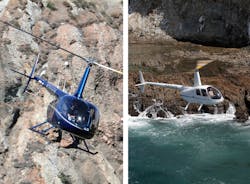Then along came the first jets, and, lo, there was jet fuel, which was much like kerosene and would not run in piston engines. Thus began the problems and all hell broke loose.
None of this mattered much at first, sure. Jet engines were mostly used by the airlines and the military. Besides, if the airplane had propellers that was a pretty good indication that it had a piston engine and used avgas.
Next came the Beech King Air and other turbo-prop aircraft, called propjets by marketers. They had props, but used turbine engines that burned jet fuel. Uh-oh! How could anyone tell which prop planes took avgas and which took jet fuel? I mean, you know, they had props, didn’t they?
Then, in the 1960s, came the Learjets and other business jets. They were smaller than airliners, but had no props, so they took jet fuel. That was easy.
Each of these steps created problems for support personnel. First, they had to learn that turbine engines did not like avgas and vice versa. That sounds simple, but there were always little surprises. Older airliners – the DC-3s, 4s, 6s, 7s, Martins, Convairs and others – were around long after the jets arrived and, indeed, some are still around today. These old planes were big and important looking, but they did have props, so that helped.
During and after the Korean War came the helicopters. At first there were the Whirly Birds, the Bell-47s, they were piston powered and most everybody knew that. In fact, many just figured that all helicopters were piston powered. Around the same time came turbine-engined helicopters which, as ground-service providers had to learn, required jet fuel.
Changing Times
I was in the aviation insurance business during many of these changes and saw the results. One truly fine FBO put a load of jet fuel into one of the old round-engine airliners. The lineperson just never had seen such a big airplane with piston engines, I reckon, and the result was disastrous.
At the FBO for which I worked, we came full-circle. Our line staff was well-trained, but the younger folks had never seen a piston-powered helicopter. Sure, enough, an old Bell-47 flew in and it was filled with jet fuel. We lucked out on that one. The pilot had been around a long time and he noticed an engine instrument indication shortly after takeoff that screamed “jet fuel, jet fuel!” He immediately put it on the ground – and I do mean immediately.
I dare say a less experienced pilot would never have noticed the flicker of that gauge. Not only that, but the pilot knew exactly how to get the engine cleaned out, our shop did the work and he flew away.
We were also worried that the farmer on whose crop the helicopter had set down might sue us. As it turned out he was one of our customers and he let us off light.
These problems were once rampant throughout aviation. To make matters worse, Piper, Beech, Cessna and others started putting out aircraft with turbo-charged piston engines. The powers-that-be asked manufacturers not to put the words “turbo charged” on the outside of the airplane, lest ground support personnel misunderstand and put jet fuel in the tanks.
Also, the military purposefully planned a switch to all turbine aircraft. They performed better and having a full fleet of them meant the military had to buy, store, handle and use only one type of fuel.
At the same time, in some places—Bermuda comes to mind—avgas wasn’t available at all, and you’d best not arrive there in a piston-powered airplane. Getting back to the mainland could be both very expensive and time consuming.
No doubt the move to jet fuel will continue. Avgas is already becoming more difficult to get in many parts of the world. One response has been to move towards small aviation diesel engines that will burn either jet fuel or diesel.
This move to “one fuel fits all” might help ground support in their eternal quest for safety and simplicity. But watch out, folks. As I write this, the Solar Impulse II is trying an around-the-world flight in a sun-powered aircraft.



